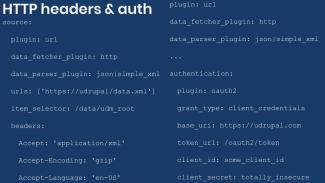
Adding HTTP request headers and authentication to remote JSON and XML in Drupal migrations
In the previous two blog posts we learned to migrate data from JSON and XML files. To provide this functionality the Migrate API leverages the Guzzle HTTP Client library. Usage requirements and limitations will be presented.
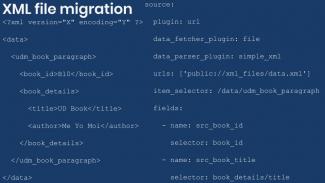
Migrating XML files into Drupal
Today we will learn how to migrate content from a XML file into Drupal using the Migrate Plus module. The example includes node, images, and paragraphs migrations. Let’s get started.

Migrating JSON files into Drupal
Today we will learn how to migrate content from a JSON file into Drupal using the Migrate Plus module. The example includes node, images, and paragraphs migrations. Let’s get started.

Migrating CSV files into Drupal
Today we learn how to migrate content from a comma-separated value (CSV) file into Drupal, using the latest version of the Migrate Source CSV module and the CSV PHP library by the PHP League. We will show how configure the source plugin to read files with or without a header row and also cover stream wrappers.
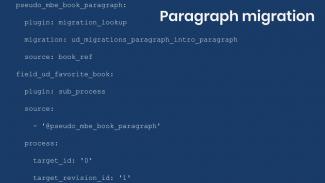
Introduction to paragraphs migrations in Drupal
Today we will present an introduction to paragraphs migrations in Drupal. The example consists of migrating paragraphs of one type, then connecting the migrated paragraphs to nodes.

Migrating dates into Drupal
Today we will learn how to migrate dates into Drupal. Depending on your field type and configuration, there are various possible combinations. In addition to the examples, a list of things to consider when migrating dates is also presented.
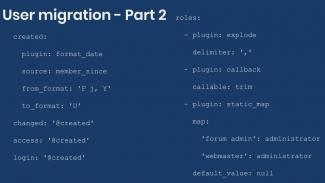
Migrating users into Drupal - Part 2
Today we complete the user migration example. This time, we cover creation date, roles, and profile pictures and we are jumping straight to the process transformations in this entry.

Migrating users into Drupal - Part 1
Today we are going to learn how to migrate users into Drupal. The example code will be explained in two blog posts. In this one, we cover the migration of email, timezone, username, password, and status.
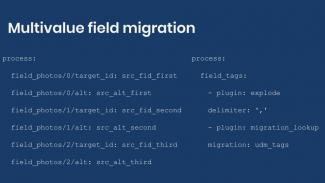
Migrating taxonomy terms and multivalue fields in Drupal
This example consists of two separate migrations. One to import taxonomy terms accounting for term hierarchy. And another to import into a multivalue taxonomy term field. Following this approach, any node and taxonomy term created by the migration process will be removed from the system upon rollback.

Introduction to migration dependencies in Drupal
One of Drupal’s biggest strengths is its data modeling capabilities. You can break the information that you need to store into individual fields and group them in content types. Today we will learn about migration dependencies in Drupal.
Pagination
- Previous page
- Page 3
- Next page

